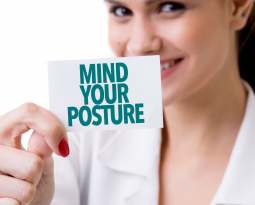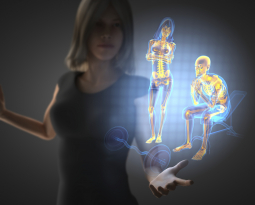
Is Your Posture Killing You?
Is Your Posture Killing You?
In this study by Dado et al we are looking at the connection between posture and early mortality. The study evaluated 1,353 elderly participants. By evaluating the participant’s kyphosis or curve of the upper part of the back, the thoracic spine, and the researchers were able to correlate an increase in early death among the elderly population. The researchers discovered that persons with a hyperkyphotic posture have a 144% greater rate of mortality. Meaning that as your posture weakens and you form this type of postural distortion pattern your chances for dying before your time come close to doubling.
The Posture of the Spine is Degenerating.
What is happening?
As the posture weakens both muscularly and structurally, the body begins to adapt to abnormal posture patterns. The Thoracic spine has a natural curve to it. This is developed by one bone (called a vertebrae) sitting on top of another in a stacking pattern. They are separated by a cushioning structure called a vertebral disc. As the muscles weaken, and extra stress is added to the vertebra and discs, the spine begins to compensate creating degeneration of the discs and vertebra. This causes the curve of the spine to increase, which actually brings the top of the spine closer to the bottom of the spine. This is one of the reasons why many people become shorter as they age. Their spines are no longer in the erect and stable position they once were.
Think of the little old lady who is bent forward and has to use a cane to hold her self up.
What does it look like?
Structurally when we have hyper kyphosis or an increased curve of the upper spine it distorts many physical aspects of the posture. You see this postural presentation regularly even though its postural affects are quite serious. This is the person that looks like they are hunched forward; their shoulders are generally rounded inwards. And they have a bit of a hump also known as a dowagers hump at the base of their neck. In extreme conditions you see the elderly person hunched over, leaning forward, usually holding onto a cane to help her stay standing. Her head is sitting forward, and she looks like she has a big round hump on her back. In the beginning this can start with rolled in shoulders, and a small bump at the base of the neck.
This postural distortion pattern puts direct stress on the spinal cord and limits your ability to breath.
How does this effect health?
The body is designed to function properly. When we change the postural design of the body we also alter the function. The most major situations from this postural distortion pattern are the effects on respiration or breathing and the pressure on the spinal cord and nerves. When the spinal curve increases causing the rounded back, it stretches the spinal cord. The spinal cord runs through a small hole or canal in the vertebra. As the vertebra flex forward, it stretches the spinal cord putting stress, and sometime direct pressure on the cord. This cord is what carries all the messages from your brain to your body.
In regards to breathing, your lungs are positioned in the upper part of your body/chest. They bring in oxygen for your heart and body by expanding to pull air in. When we bend forward, or have this postural distortion pattern we are actually limiting the space our lungs have to expand. With each breath we have reduced the space, limiting the amount of air we can breath in, which then limits the oxygen that is supplied to our heart and body. Having reduced oxygen in the body can cause many serious health issues, and more commonly noticed are issues such as chronic fatigue, dizziness, and even headaches. Additional health issues caused by this postural distortion pattern are muscle fatigue, back pain, herniated discs, and fractures of the vertebra, arthritis and osteoporosis.
Sitting all day with incorrect posture can cause this.
How does this happen?
As with all postural distortion patterns, it is developed overtime by your habits and lifestyle. This postural distortion pattern most commonly occurs in those who are seated for long periods of time. Someone working on a computer or sitting at a desk. When we allow our core muscles to relax, we lose the support to sit up straight. This causes the thoracic spine to flex forward giving us that postural compensation pattern. Maintaining this position over time is one of the factors to what causes this postural distortion pattern. Having our hands positioned in front of us with our shoulders rolled in, as if typing on a computer is the exact position that creates this posture issue. With posture, you either have good posture or you don’t there is no in between.
Check the base of your neck for the formation of a hump in your spine.
How can I check it?
Why don’t you take a second and feel the top of your back, or where your neck meets your shoulders. Do you feel a hump there? If so you may be starting to develop this postural distortion pattern. The best way to know for sure if you are developing this postural distortion pattern is to have a postural analysis. Unfortunately there are not many Postural Specialists readily available to perform this service. Because of the importance for you to know your posture, the American Posture Institute provides an incredible service called Posture Diagnosis Online. This is where a Certified Postural Specialist will evaluate your posture through a picture, and give you specific findings in regards to your posture, potential distortion patterns, as well as possible future complications that could occur if not corrected. For more information on this go to www.AmericanPostureInstitute.com.
Use a Posture Reminder to become conscious of your posture.
How do I correct it?
Now that we know we have this issue how can we correct it? Most importantly, in dealing with postural distortion patterns is prevention. It is not only more effective, but it is much quicker and easier to correct these problems before they happen. There are three fundamental concepts when correcting posture: Spinal alignment, postural rehabilitation and postural habit re-education. Here we will briefly focus on the habits of those who sit at a desk regularly. We must retrain our body what proper posture is. This involves being consciously aware of our posture in order to change it. To break this postural distortion pattern we must first sit up straight and take mini posture breaks. When working we often forget to stay in good posture and to take posture breaks. However, these are vital in changing our posture. A great tip that I use with all my patients is a Posture Sticker. Take a sticker, or any object really, and label it your posture reminder. Place this sticker at your desk where you can see it regularly. Every time you see this sticker you remember to sit up straight, tighten your core/stomach muscles, pull your shoulders back, and bring your head over your shoulders, as if you were pulling your chin back. If every time you see this reminder you perform this action you will begin to strengthen your postural muscles, and develop the proper postural habits. Additionally, every 30 minutes stand up from your desk, take 20 seconds and stretch. Stretch your arms to the ceiling, bend from one side to the other, and move around in place. When we stay seated for too long in one position the static load on our spines begins to increase, causing the spinal degeneration we spoke of. By staying consciously aware of correct posture and taking mini posture breaks during the day to stretch you will be moving in the right direction for changing your posture into good posture.
For more tips like these, or for a posture correction program visit www.AmericanPostureInstitute.com.
Reference:
Hyperkyphotic Posture Predicts Mortality in Older Community-Dwelling Men and Women: A Prospective Study Journal of the American Geriatrics Society Volume 52 Issue 10 Page 1662 – October 2004. Deborah M. Kado, MD, MS, Mei-Hua Huang, DrPH, Arun S. Karlamangla, MD, PhD, Elizabeth Barrett-Connor, MD and Gail A. Greendale, MD

















